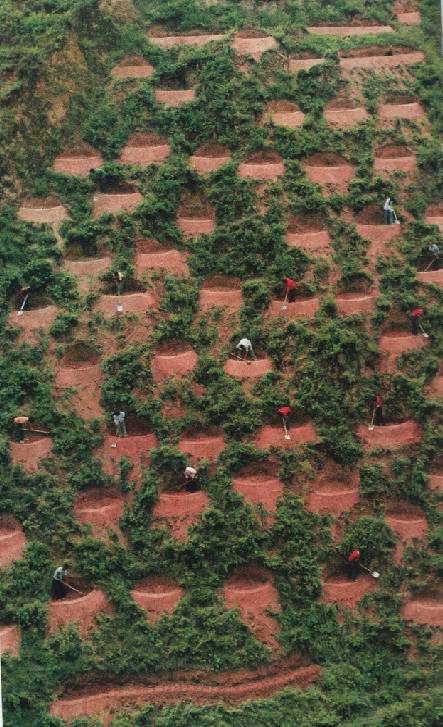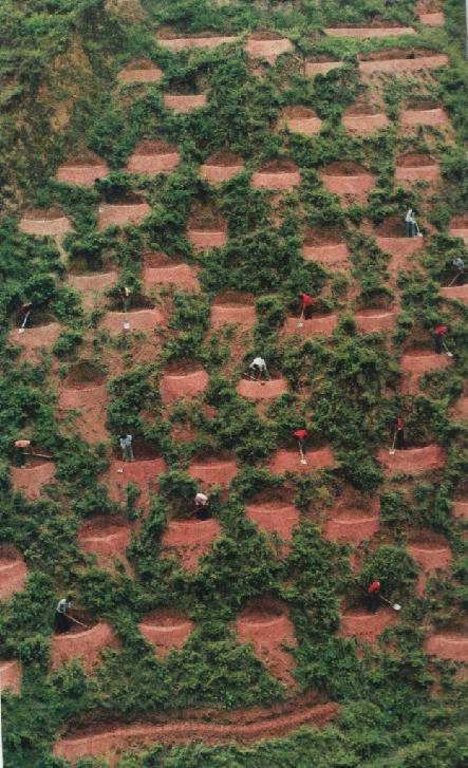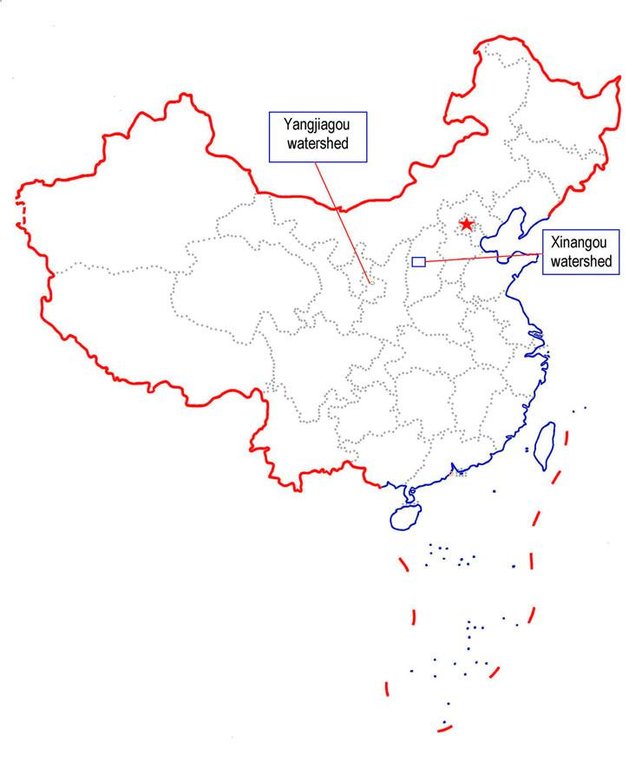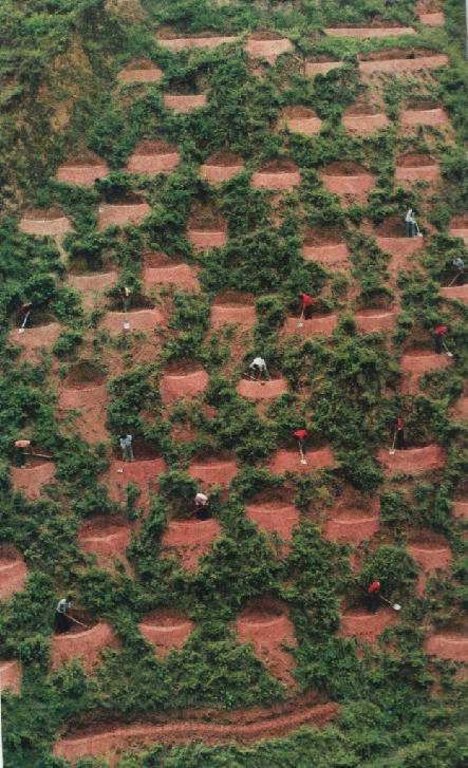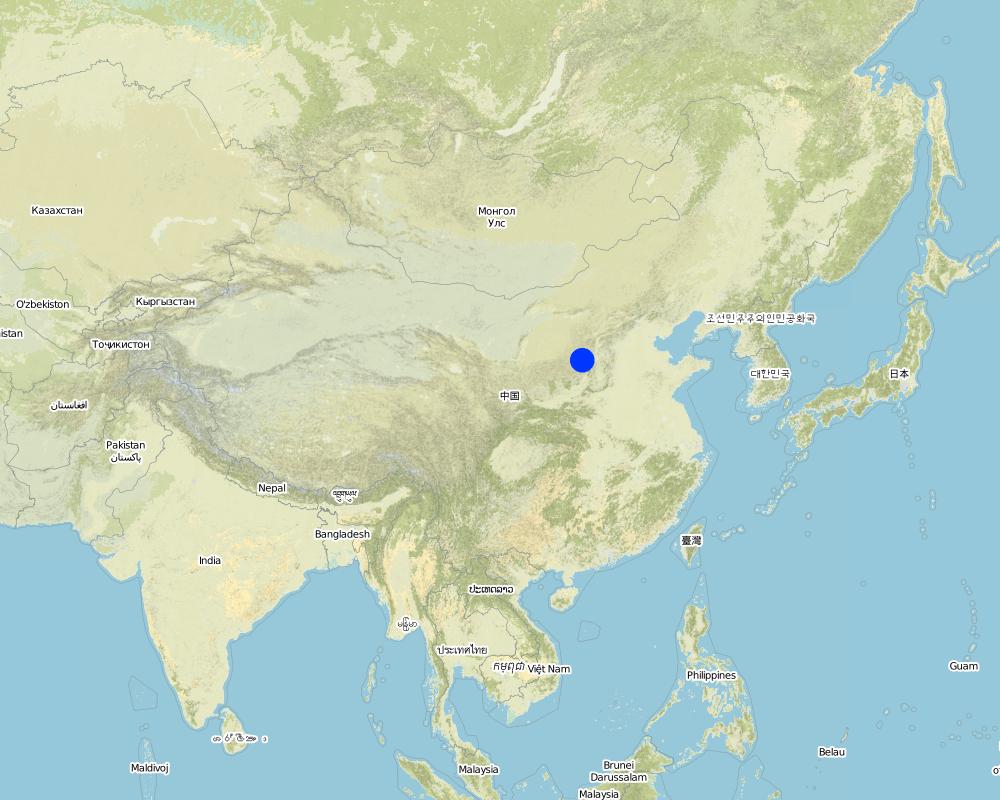Pits [China]
- Creation:
- Update:
- Compiler: Baoyuan Liu
- Editor: –
- Reviewer: Laura Ebneter
approaches_2555 - China
View sections
Expand all Collapse all1. General information
1.2 Contact details of resource persons and institutions involved in the assessment and documentation of the Approach
Name of the institution(s) which facilitated the documentation/ evaluation of the Approach (if relevant)
Department of Resources and Environmental Science, Beijing Normal University (Department of Resources and Environmental Science, Beijing Normal University) - China1.3 Conditions regarding the use of data documented through WOCAT
The compiler and key resource person(s) accept the conditions regarding the use of data documented through WOCAT:
Yes
2. Description of the SLM Approach
2.1 Short description of the Approach
The pits are constructed by hand on steep slope by government investment.
2.2 Detailed description of the Approach
Detailed description of the Approach:
The purpose is to control soil loss and protect environment. Hence the pits are constructed on steep slope. To control watershed erosion, government have to invest. Soil and water conservation bureau is in charge of planning and implementation. Farmers provide labors to construct pits. Tools are shovel and hoes. Pits are constructed on steep slope, so mechanical machine can not be used.
2.3 Photos of the Approach
2.5 Country/ region/ locations where the Approach has been applied
Country:
China
Region/ State/ Province:
Gansu, Shanxi
Map
×2.6 Dates of initiation and termination of the Approach
Indicate year of initiation:
1958
Year of termination (if Approach is no longer applied):
2005
2.7 Type of Approach
- project/ programme based
2.8 Main aims/ objectives of the Approach
The aim is to control soil and water loss and protect environment.
The SLM Approach addressed the following problems: Pit is one of the structural measures to control steep slope soil and water loss. It is difficult to build using mechanical machine but easy to make by hand with simple tools.
2.9 Conditions enabling or hindering implementation of the Technology/ Technologies applied under the Approach
availability/ access to financial resources and services
- hindering
Only when government invests, the technology can be implemented
Treatment through the SLM Approach: investment
legal framework (land tenure, land and water use rights)
- hindering
The existing land ownership, land use rights / water rights hindered a little the approach implementation Land resources belongs to state and land user can only lease the land for a period of time, land users worry about their land would be transferred to others.
3. Participation and roles of stakeholders involved
3.1 Stakeholders involved in the Approach and their roles
- local land users/ local communities
existing groups of land users; Specific ethnic groups:: Islam, Korea.; Working land users were mainly men (Men are the main work forces to build the pits.)
- national government (planners, decision-makers)
3.2 Involvement of local land users/ local communities in the different phases of the Approach
| Involvement of local land users/ local communities | Specify who was involved and describe activities | |
|---|---|---|
| initiation/ motivation | interactive | interviews/questionnaires; Land users participate. |
| planning | interactive | No land users participate |
| implementation | interactive | responsibility for major steps; No land users participate |
| monitoring/ evaluation | passive | No land users participate |
| Research | passive | No land users participate |
3.4 Decision-making on the selection of SLM Technology/ Technologies
Specify who decided on the selection of the Technology/ Technologies to be implemented:
- SLM specialists alone
Explain:
Decisions on the choice of SLM Technology were made directive (top-down).
Decisions on the method of implementing the SLM Technology were made by politicians / leaders (directive ,top-down).
4. Technical support, capacity building, and knowledge management
4.1 Capacity building/ training
Was training provided to land users/ other stakeholders?
Yes
Specify who was trained:
- land users
- planners
Form of training:
- farmer-to-farmer
- demonstration areas
Subjects covered:
Mainly setup demonstration areas for visit and illustrate.
4.2 Advisory service
Do land users have access to an advisory service?
Yes
Describe/ comments:
Name of method used for advisory service: Local government and SWC station (office).; Key elements: Planning, Build pits, Maintaining; 1) Advisory service was carried out through: projects own extension structure and agents 2) Advisory service was carried out through: projects own extension structure and agents; Extension staff: mainly government employees 3) Target groups for extension: land users
Advisory service is quite adequate to ensure the continuation of land conservation activities; At each government level, there is a SWC office which is in charge of SWC activities including extension.
4.3 Institution strengthening (organizational development)
Have institutions been established or strengthened through the Approach?
- no
4.4 Monitoring and evaluation
Is monitoring and evaluation part of the Approach?
Yes
Comments:
area treated aspects were ad hoc monitored through measurements
land users involved aspects were ad hoc monitored through measurements
There were no changes in the Approach as a result of monitoring and evaluation
4.5 Research
Was research part of the Approach?
Yes
Specify topics:
- technology
Give further details and indicate who did the research:
Research was carried out on-farm
5. Financing and external material support
5.1 Annual budget for the SLM component of the Approach
If precise annual budget is not known, indicate range:
- 100,000-1,000,000
Comments (e.g. main sources of funding/ major donors):
Approach costs were met by the following donors: government (national - state): 100.0%
5.3 Subsidies for specific inputs (including labour)
- equipment
| Specify which inputs were subsidised | To which extent | Specify subsidies |
|---|---|---|
| tools | partly financed | |
- infrastructure
| Specify which inputs were subsidised | To which extent | Specify subsidies |
|---|---|---|
| community infrastructure | partly financed | |
If labour by land users was a substantial input, was it:
- paid in cash
5.4 Credit
Was credit provided under the Approach for SLM activities?
No
6. Impact analysis and concluding statements
6.1 Impacts of the Approach
Did the Approach help land users to implement and maintain SLM Technologies?
- No
- Yes, little
- Yes, moderately
- Yes, greatly
The wrapped water by pits can plant SWC trees and other fruit trees.
Did the Approach improve issues of land tenure/ user rights that hindered implementation of SLM Technologies?
- No
- Yes, little
- Yes, moderately
- Yes, greatly
Local government can manage it. The problem is likely to be overcome in the near future. Prolonging the contract period of the leased land.
Did other land users / projects adopt the Approach?
- No
- Yes, little
- Yes, moderately
- Yes, greatly
6.3 Sustainability of Approach activities
Can the land users sustain what has been implemented through the Approach (without external support)?
- uncertain
If no or uncertain, specify and comment:
If there is not continuously financial support.
6.4 Strengths/ advantages of the Approach
| Strengths/ advantages/ opportunities in the land user’s view |
|---|
| It is better to make pits in the farming leisure time(winter). |
| It is easy to build a pit |
| low inupt and land users can bear (How to sustain/ enhance this strength: With favourable policies) |
| Strengths/ advantages/ opportunities in the compiler’s or other key resource person’s view |
|---|
| easy to make pits (How to sustain/ enhance this strength: Repairing and planting trees in pits timely) |
| harvest water on steep slope (How to sustain/ enhance this strength: Reasonable size of pits based on local rainfall.) |
| Better ecological benefits (How to sustain/ enhance this strength: Partly financial support.) |
6.5 Weaknesses/ disadvantages of the Approach and ways of overcoming them
| Weaknesses/ disadvantages/ risks in the land user’s view | How can they be overcome? |
|---|---|
| Not any economic benefits | Planting economic trees or fruit trees. |
| Not any funds for maintain exsiting pits. | subsidy. |
| Weaknesses/ disadvantages/ risks in the compiler’s or other key resource person’s view | How can they be overcome? |
|---|---|
| Little economical return | Planting economic trees or fruit trees. |
7. References and links
7.1 Methods/ sources of information
- field visits, field surveys
- interviews with land users
7.2 References to available publications
Title, author, year, ISBN:
Zhou yugui, Zhang cheng. Effectively comprehensive control in Xinangou watershed, 2000.
Available from where? Costs?
Soil and Water Conservation Science and Technology in Shanxi, 6, 36-38
Title, author, year, ISBN:
Wang ling. Pits in soil and stone hilly area, 1984.
Available from where? Costs?
Soil and Water Conservation in China. 11, 14-16.
Title, author, year, ISBN:
Li yanchang. Storage capability and excavating volume of pits, 1984.
Available from where? Costs?
Soil and Water Conservation in China. 11, 17-19.
Title, author, year, ISBN:
Yang yansheng. Technological measures suitable for red earth region in southern China, 1999.
Available from where? Costs?
Research of Soil and Water Conservation. 6(2):117-120.
Title, author, year, ISBN:
Dou yuqin. Hydraulic property and design criterion of pits, 1986.
Available from where? Costs?
Bulletin of Soil and Water Conservation.,4,53-58.
Title, author, year, ISBN:
Shi shengxin, Jiang dingsheng. Impacts of several soil and water conservation measures on strengthening rainfall infiltration and reducing sediment yield, 1994.
Available from where? Costs?
Research of Soil and Water Conservation. 1(1): 82-88.
Title, author, year, ISBN:
Mu Xingmin, Chen jiwei. Effects of measures of soil and water conservation on soil water content in the Loess Plateau, 1996.
Available from where? Costs?
Journal of Soil Erosion and Soil and Water Conservation, 5(4):39-41.
Title, author, year, ISBN:
Mu xingmin, Wang wenlong, Xu xuexuan. The influence of the soil and water conservation on the surface runoff in the watersheds in the gully plateau region of Loess Plateau, 1999.
Available from where? Costs?
Journal of Hydraulic, 2:71-75.
Links and modules
Expand all Collapse allLinks
No links
Modules
No modules


